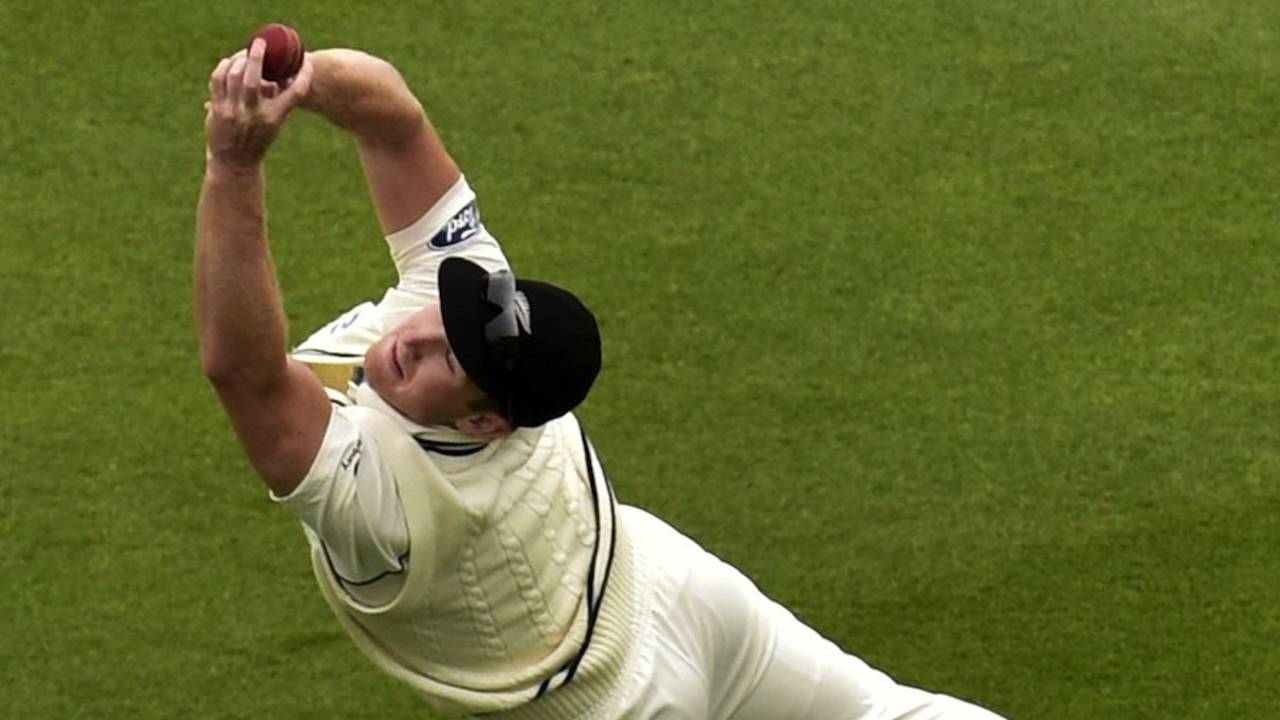New Zealand's potent modus operandi
Sri Lanka had victory in sight with the opposition effectively 24 for 5 in the second innings, yet the gulf in the teams' fielding sent New Zealand to their 193-run win, Angelo Mathews said
Andrew Fidel Fernando at Basin Reserve
07-Jan-2015
New Zealand's best fielders barely have time to feel nervous, so quickly are they reacting to ball coming off willow • AFP
When Kaushal Silva cut a ball behind point early in the 29thth over of the innings, third slip, fourth slip, gully and point peeled off to give chase.
Kumar Sangakkara had already been dismissed. Sri Lanka were 66 for 3, in pursuit of 390. Most teams would commit one man to this errand, some might send two. But here was more than a third of New Zealand's fielding resources tearing after it; in each other's slipstream like a track cycling outfit, even though this ball seemed destined for the fence.
Somehow, between the four of them, they found a way to haul it in, one man scooping it back from the rope, another plucking it up and returning it. Each of the four fielders then high-fived the others - even the two that had not touched the ball. Seven high-fives in all. One run saved.
It has been like this all series. The New Zealand XI has fielded like they have had twice that number on the ground. It has been like this for all of the past year, with bat and ball as well. New Zealand commit men to the pursuit of the seemingly impossible. Somehow, someone scoops it back. Somehow they find a way.
That rarest of sporting achievements: the backs-to-the-wall triumph, has now become almost as routine for New Zealand as the stellar takes that electrify the home crowds that have grown in the past two summers. Just in this Test, Trent Boult plucked one from the skies at backward point, before Kane Williamson leapt high, feet well off the ground, to snatch one at gully, on the last day. For most sides, these are catches that come about once a year. For Boult and Williamson, neither effort is even their best in the past six months.
While New Zealand dismissed Sri Lanka's two best batsmen - Kumar Sangakkara and Angelo Mathews - with those catches, Sri Lanka will reflect they could have won this match if one of three straightforward chances off Williamson had been snaffled. Sri Lanka had victory in sight with the opposition effectively 24 for 5 in the second innings, yet the gulf in the teams' fielding sent New Zealand to their 193-run win, Mathews said. Sri Lanka have been a woeful catching team in Tests for some time now.
"I think clearly the difference in this game was the fielding," Mathews said. "New Zealand grabbed every opportunity that came their way and we didn't and we have to pay the price. We just can't keep repeating the same old mistakes. In training we work hard on our fielding , but it's just the nerves I think, at that point of time."
New Zealand's best fielders barely have time to feel nervous, so quickly are they reacting to ball coming off willow. They are not just trained, they appear mentally conditioned to hunt down leather. Sometimes the batsman will hit through point, but the man all the way at mid-on moves to go after it, before reason kicks in to override impulse.
The effort is impeccable from overs one to 20, to 120. Sri Lanka's fielders were virtually dragging the meat of their own carcasses around the Basin Reserve towards the end of New Zealand's second innings. New Zealand were whizzing about the same ground like pinballs during Sangakkara's day-two onslaught. Having enforced the follow-on at Hagley Oval, New Zealand were in the field for over 196 overs, yet were reeling in firmly struck balls across the two-and-a-half days. "Every run is important," preaches McCullum. Right across the team, there are no broken links. No lethargic runners to sneak singles from. No weak arms, from which to make a two into a three.
Occasional mistakes are made, of course, as they always will be in a sport played by humans. But even after a chance is shelled, each New Zealand fielder seems to want the next ball to come to him. In Christchurch, Ross Taylor let a simple slip catch spill from his bucket hands, but held firm to a more difficult chance moments later. In the same match, Sangakkara grassed one off McCullum, then within half an hour, had dropped James Neesham as well.
The whole operation is set off by the man who evades notice. BJ Watling has a lot of chances come his way, with the attack New Zealand possess, but in this series he has been immaculate, thoroughly outshining, with the bat as well as gloves, an opposite number who once could lay claim to being the best wicketkeeper in the world. In 2014, no one had more dismissals than his 40.
New Zealand have had many heroes recently, from McCullum and his triple-hundred last year, to Mark Craig's 10-wicket haul at Sharjah, and now Williamson's double-ton at the Basin Reserve. No one will have a plaque unveiled in their honour for cutting off a boundary, or receive the keys to the city for pouching safely at slip, but New Zealand amplify the threat of the collective like no other side, and their opponents will continue to discover that can be the difference between victory and defeat.
Andrew Fidel Fernando is ESPNcricinfo's Sri Lanka correspondent. @andrewffernando
